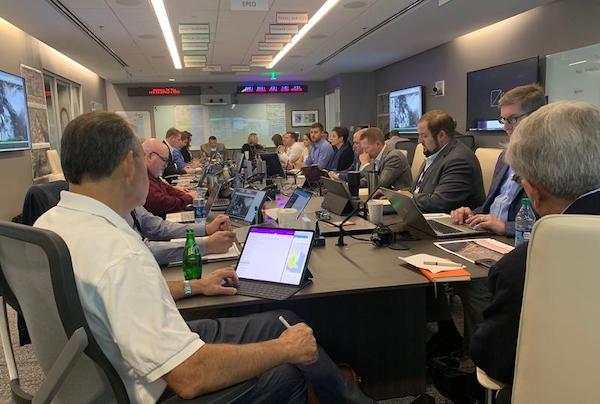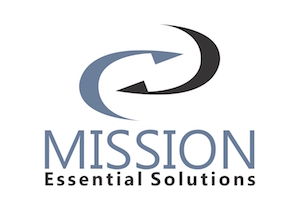Emergency Preparedness and Response (EPR)
See the following -
Ebola in the United States: Short on Accountable 'Open' Information, Effective Systems Planning and Decision Making
 Events in the present Ebola crisis prompt unease that the United States deployment of Web based, standardized population health and biosurveillance information services is fragmented, incomplete and insufficient, prompting me to write this blog. The United States has made significant progress in public health and medical preparedness since the 9/11 terrorist attacks; yet, poorly interconnected information systems add to our vulnerability to planning and response to viruses like Ebola or enviro virus EV-D68 that threaten the health of large populations. Today, a gap exists between information technology specialists and public health programmatic or scientific personnel.
Events in the present Ebola crisis prompt unease that the United States deployment of Web based, standardized population health and biosurveillance information services is fragmented, incomplete and insufficient, prompting me to write this blog. The United States has made significant progress in public health and medical preparedness since the 9/11 terrorist attacks; yet, poorly interconnected information systems add to our vulnerability to planning and response to viruses like Ebola or enviro virus EV-D68 that threaten the health of large populations. Today, a gap exists between information technology specialists and public health programmatic or scientific personnel.
- Login to post comments
Frost & Sullivan Applauds CORAnet™'s Efforts to Strengthen its Brand in the Competitive Mobile Electronic Health Record Market
 Based on its recent analysis of the mobile electronic health record (EHR) market, Frost & Sullivan recognizes CORAnet™ with the 2017 North America Frost & Sullivan Award for Competitive Strategy Innovation and Leadership. CORAnet™ has emerged a successful, cloud-based mobile technology solution provider, offering first responders, doctors, and individual patients 24/7 secure access to personal health records (PHRs). Its advanced software makes possible real-time access to EHR data that is exchangeable along the entire care continuum. This capability is the result of its deep understanding of sophisticated EHR healthcare information technology, health information exchanges, mobile applications, HIPAA and MU3 compliance requirements.
Based on its recent analysis of the mobile electronic health record (EHR) market, Frost & Sullivan recognizes CORAnet™ with the 2017 North America Frost & Sullivan Award for Competitive Strategy Innovation and Leadership. CORAnet™ has emerged a successful, cloud-based mobile technology solution provider, offering first responders, doctors, and individual patients 24/7 secure access to personal health records (PHRs). Its advanced software makes possible real-time access to EHR data that is exchangeable along the entire care continuum. This capability is the result of its deep understanding of sophisticated EHR healthcare information technology, health information exchanges, mobile applications, HIPAA and MU3 compliance requirements.
- Login to post comments
Government of St. Maarten Launches Program to Train Students in Emergency Preparedness and Response Skills
 The Government of Sint Maarten is pleased to announce the launch of the Youth Emergency Hero (YEH) program that teaches school students how to prepare themselves, their households and their communities for emergencies and stay safe during disasters. The curriculum is provided by University instructors at the Caribbean Center for Disaster Medicine at the American University of the Caribbean School of Medicine on St. Maarten.
The Government of Sint Maarten is pleased to announce the launch of the Youth Emergency Hero (YEH) program that teaches school students how to prepare themselves, their households and their communities for emergencies and stay safe during disasters. The curriculum is provided by University instructors at the Caribbean Center for Disaster Medicine at the American University of the Caribbean School of Medicine on St. Maarten.
- Login to post comments
HCA Healthcare Can't Hide From Hurricanes With 45 Hospitals In Florida, So It Preps Like It's The Apocalypse
 As Hurricane Dorian threatened the Florida coast, top officials at HCA spent Labor Day weekend wringing their hands, pulling all-nighters in a Nashville command center. It almost didn't matter where the storm hits; HCA Healthcare's hospitals were going to be affected. With dozens of hospitals on Florida's east and west coasts, the for-profit hospital chain is exposed every time a hurricane threatens the Sunshine State. Late last week, the nation's largest hospital company granted WPLN rare access to observe storm preparations as Dorian bore down on the Florida coast. The mood was serious. Chatter was limited. The only sound competing with speakers was the hum of fingers on laptops taking furious notes.
As Hurricane Dorian threatened the Florida coast, top officials at HCA spent Labor Day weekend wringing their hands, pulling all-nighters in a Nashville command center. It almost didn't matter where the storm hits; HCA Healthcare's hospitals were going to be affected. With dozens of hospitals on Florida's east and west coasts, the for-profit hospital chain is exposed every time a hurricane threatens the Sunshine State. Late last week, the nation's largest hospital company granted WPLN rare access to observe storm preparations as Dorian bore down on the Florida coast. The mood was serious. Chatter was limited. The only sound competing with speakers was the hum of fingers on laptops taking furious notes.
- Login to post comments
Hiding Our Heads in the Sand - Why the US is Unprepared for Pandemics and Disasters
 A new report from the Trust for America's Health minces no words. President and CEO John Auerbach charges: COVID-19 has shined a harsh spotlight on the country's lack of preparedness for dealing with threats to Americans' well-being. Years of cutting funding for public health and emergency preparedness programs has left the nation with a smaller-than-necessary public health workforce, limited testing capacity, an insufficient national stockpile, and archaic disease tracking systems - in summary, twentieth-century tools for dealing with twenty-first-century challenges.
A new report from the Trust for America's Health minces no words. President and CEO John Auerbach charges: COVID-19 has shined a harsh spotlight on the country's lack of preparedness for dealing with threats to Americans' well-being. Years of cutting funding for public health and emergency preparedness programs has left the nation with a smaller-than-necessary public health workforce, limited testing capacity, an insufficient national stockpile, and archaic disease tracking systems - in summary, twentieth-century tools for dealing with twenty-first-century challenges.
- Login to post comments
How Laboratories and their Systems can Weather Natural Disasters and Pandemics
 We are currently experiencing a global pandemic - which, while perhaps included in disaster preparedness Standard Operating Procedures (SOPs) by many labs as a possible disaster, still has caught most the infrastructure and health systems of most nations largely unprepared, and is causing major disruption because it was arguably not seen as one of the most likely events. Disaster preparedness has typically tended to focus on IT and data management risks and/or natural disasters. SOPs center around standard, daily lab safety. The truth is that whatever the odds of a particular disaster, they become 100% once they happen. It's important to have sufficient risk-reduction SOPs in play, and a good Continuity Of Operations Plan (COOP) for each potential scenario to ensure the best chance of coping during the event and recovering afterwards.
We are currently experiencing a global pandemic - which, while perhaps included in disaster preparedness Standard Operating Procedures (SOPs) by many labs as a possible disaster, still has caught most the infrastructure and health systems of most nations largely unprepared, and is causing major disruption because it was arguably not seen as one of the most likely events. Disaster preparedness has typically tended to focus on IT and data management risks and/or natural disasters. SOPs center around standard, daily lab safety. The truth is that whatever the odds of a particular disaster, they become 100% once they happen. It's important to have sufficient risk-reduction SOPs in play, and a good Continuity Of Operations Plan (COOP) for each potential scenario to ensure the best chance of coping during the event and recovering afterwards.
- Login to post comments
How The VA and UL Created an Orchestrated Approach to Healthcare Cybersecurity Assurance
 In today's high-risk Internet of Medical Things (IoMT) and cyber-warfare environment, one tool or individual line of cybersecurity solutions would likely not be able to satisfy the requirements for security and safety put forth by an HDO; hence, the aggregation of solutions branded as MedFusion was derived. The VA UL CRADA discovered that healthcare is strengthened in terms of security and safety of connectable medical devices through in-depth cybersecurity defense...Learning from the VA and UL cybersecurity research results, with respect to product-level management of vulnerabilities and threats to medical devices and their associated software algorithms, we can impact the quality of adoption of electronic health records and other data collection systems connected to the IoMT and consumers...
In today's high-risk Internet of Medical Things (IoMT) and cyber-warfare environment, one tool or individual line of cybersecurity solutions would likely not be able to satisfy the requirements for security and safety put forth by an HDO; hence, the aggregation of solutions branded as MedFusion was derived. The VA UL CRADA discovered that healthcare is strengthened in terms of security and safety of connectable medical devices through in-depth cybersecurity defense...Learning from the VA and UL cybersecurity research results, with respect to product-level management of vulnerabilities and threats to medical devices and their associated software algorithms, we can impact the quality of adoption of electronic health records and other data collection systems connected to the IoMT and consumers...
- Login to post comments
In Disasters Such as Hurricanes, HIE Is 'As Critical as Having Roads, as Having Fire Hydrants'
 The Statewide Health Information Network of New York (SHIN-NY) sees itself as a "public utility" as much as an HIE. In the wake of Hurricane Sandy, as patients bounce between hospitals (and as other public utilities, such as electricity and transportation, are compromised), it has enabled critical continuity of care. The images of dozens of red-flashing ambulances, evacuating as many as 200 patients – some of them in critical condition, some of them infants – from NYU Langone Medical Center, whose backup generator had failed, to hospitals such as Sloan-Kettering and NewYork-Presbyterian, will be some of the most enduring images from the super storm. The harrowing process was made much smoother by the fact that those patients' electronic health records were secure and readily accessible at the hospitals to which they were thanks to New York's statewide HIE... Read More »
The Statewide Health Information Network of New York (SHIN-NY) sees itself as a "public utility" as much as an HIE. In the wake of Hurricane Sandy, as patients bounce between hospitals (and as other public utilities, such as electricity and transportation, are compromised), it has enabled critical continuity of care. The images of dozens of red-flashing ambulances, evacuating as many as 200 patients – some of them in critical condition, some of them infants – from NYU Langone Medical Center, whose backup generator had failed, to hospitals such as Sloan-Kettering and NewYork-Presbyterian, will be some of the most enduring images from the super storm. The harrowing process was made much smoother by the fact that those patients' electronic health records were secure and readily accessible at the hospitals to which they were thanks to New York's statewide HIE... Read More »
- Login to post comments
In Hurricane’s Wake, Decisions Not To Evacuate Hospitals Raise Questions
 Now, in the late evening hours, the worst-case scenario was unfolding at the main campus of NYU's Langone Medical Center in Manhattan, which had lost much of its backup power at the height of the storm. Could North Shore-LIJ dispatch ambulances from its Lenox Hill Hospital in New York City to pick up four critically ill babies from the neo-natal intensive care unit? New York City hospital and nursing home patients and their loved ones might reasonably have believed they were safe as Hurricane Sandy approached. Mayor Michael Bloomberg had exempted hospitals and nursing homes in low-lying "Zone A" areas of the city from his pre-storm evacuation order. Much thought and planning had gone into the decision to "shelter in place."
Now, in the late evening hours, the worst-case scenario was unfolding at the main campus of NYU's Langone Medical Center in Manhattan, which had lost much of its backup power at the height of the storm. Could North Shore-LIJ dispatch ambulances from its Lenox Hill Hospital in New York City to pick up four critically ill babies from the neo-natal intensive care unit? New York City hospital and nursing home patients and their loved ones might reasonably have believed they were safe as Hurricane Sandy approached. Mayor Michael Bloomberg had exempted hospitals and nursing homes in low-lying "Zone A" areas of the city from his pre-storm evacuation order. Much thought and planning had gone into the decision to "shelter in place."
- Login to post comments
Incident Command System Should Not Be Used For Continuity Of Operations
 Let me reiterate, the INCIDENT Command System (ICS) should not be used as the organizational structure to continue operations. No way, no how. I promised a few articles ago I was going to tackle this issue – an issue which has evolved over the last 20 years or so. I will add my theories on why a preponderance of well-intentioned folks have advocated the ICS structure be used as the “logical” (to them) structure to continue the operations of an organization. I believe I speak authoritatively on this having had both feet squarely planted in emergency management and continuity communities over the past 33 years.
Let me reiterate, the INCIDENT Command System (ICS) should not be used as the organizational structure to continue operations. No way, no how. I promised a few articles ago I was going to tackle this issue – an issue which has evolved over the last 20 years or so. I will add my theories on why a preponderance of well-intentioned folks have advocated the ICS structure be used as the “logical” (to them) structure to continue the operations of an organization. I believe I speak authoritatively on this having had both feet squarely planted in emergency management and continuity communities over the past 33 years.
- Login to post comments
Infrastructure And Resilience --- The New Pride And Prejudice
 I was going about my normal business the other day when an article from the Associated Press written by Matthew Daly And Hope Yen, and titled "Lawmakers: Ida damage shows need for infrastructure upgrades" landed in my inbox. I’m one of those weird people that sees “lawmakers” and “infrastructure” in a sentence, and am drawn to it with amused interest. Usually, I am interested academically…a lot of other times as a pure masochist…and still more often than not, like this time, with snarky anticipation. “Oh, what joyous, twisted misinformation do we have here?” The article summarizes quite aptly (kudos to Mr. Daly and Ms. Yen) the rationale applied for the monstrous, record-smashing infrastructure bills being batted about the House and Senate.
I was going about my normal business the other day when an article from the Associated Press written by Matthew Daly And Hope Yen, and titled "Lawmakers: Ida damage shows need for infrastructure upgrades" landed in my inbox. I’m one of those weird people that sees “lawmakers” and “infrastructure” in a sentence, and am drawn to it with amused interest. Usually, I am interested academically…a lot of other times as a pure masochist…and still more often than not, like this time, with snarky anticipation. “Oh, what joyous, twisted misinformation do we have here?” The article summarizes quite aptly (kudos to Mr. Daly and Ms. Yen) the rationale applied for the monstrous, record-smashing infrastructure bills being batted about the House and Senate.
- Login to post comments
Mission Essential Solutions
 Mission Essential Solutions, LLC (MES), founded in 2013, offers technical solutions aimed at providing robust mobile capabilities needed for disaster response and recovery operations. James Murphy, President and Owner of the company, is a former Marine helicopter pilot with extensive experience in disaster relief operations, flying humanitarian missions in Puerto Rico and Sierra Leone, and supporting relief operations on the ground following an earthquake and a super typhoon in the Philippines. Before retiring from the Marines in 2012, Mr. Murphy worked at the White House Military Office where he worked in disaster and emergency planning for the President of the United States and the Executive Branch Departments and Agencies.
Mission Essential Solutions, LLC (MES), founded in 2013, offers technical solutions aimed at providing robust mobile capabilities needed for disaster response and recovery operations. James Murphy, President and Owner of the company, is a former Marine helicopter pilot with extensive experience in disaster relief operations, flying humanitarian missions in Puerto Rico and Sierra Leone, and supporting relief operations on the ground following an earthquake and a super typhoon in the Philippines. Before retiring from the Marines in 2012, Mr. Murphy worked at the White House Military Office where he worked in disaster and emergency planning for the President of the United States and the Executive Branch Departments and Agencies.
- Login to post comments
ONC Timeline for TEFCA Going Live in 2022
 Today we are pleased to announce the timeline for the Trusted Exchange Framework and Common Agreement (TEFCA). The 21st Century Cures Act, signed by President Obama in 2016, calls on ONC to "develop or support a trusted exchange framework, including a common agreement among health information networks nationally."... The timeline released today-for completion of the Trusted Exchange Framework, the Common Agreement Version 1 and the Qualified Health Information Network (QHIN) Technical Framework (QTF) Version 1-establishes our goal to have this new network open for participation in the first quarter (Q1) of calendar year 2022.
Today we are pleased to announce the timeline for the Trusted Exchange Framework and Common Agreement (TEFCA). The 21st Century Cures Act, signed by President Obama in 2016, calls on ONC to "develop or support a trusted exchange framework, including a common agreement among health information networks nationally."... The timeline released today-for completion of the Trusted Exchange Framework, the Common Agreement Version 1 and the Qualified Health Information Network (QHIN) Technical Framework (QTF) Version 1-establishes our goal to have this new network open for participation in the first quarter (Q1) of calendar year 2022.
- Login to post comments
Open Source in the Worldwide COVID-19 Response
 February marks the celebration of creation of the Open Source Initiative (OSI) in 1998. OSI created the standard definition of the term Open Source that helped guide many of LPI's initiatives today. Through the past year, open source provided many opportunities to organizations to continue to work, implement their projects, and continue reaching out to communities. Here are just a few examples of how open source provides opportunities through the face of COVID-19. The COVID-19 crisis brought out all the creativity of the open source movement. In every area of innovation--open source software, open data, open collaboration, and even open equipment--companies and research institutes have addressed medical and public health needs quickly. This article highlights some of the initiatives in each area.
February marks the celebration of creation of the Open Source Initiative (OSI) in 1998. OSI created the standard definition of the term Open Source that helped guide many of LPI's initiatives today. Through the past year, open source provided many opportunities to organizations to continue to work, implement their projects, and continue reaching out to communities. Here are just a few examples of how open source provides opportunities through the face of COVID-19. The COVID-19 crisis brought out all the creativity of the open source movement. In every area of innovation--open source software, open data, open collaboration, and even open equipment--companies and research institutes have addressed medical and public health needs quickly. This article highlights some of the initiatives in each area.
- Login to post comments
